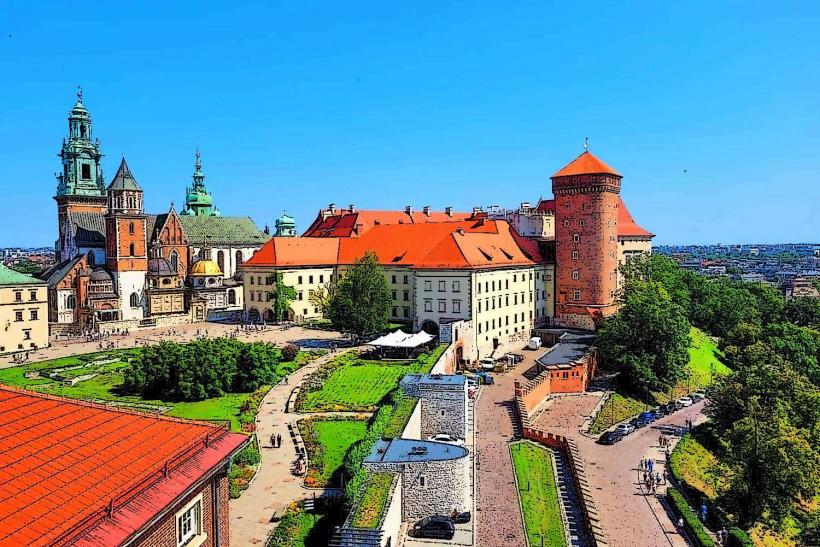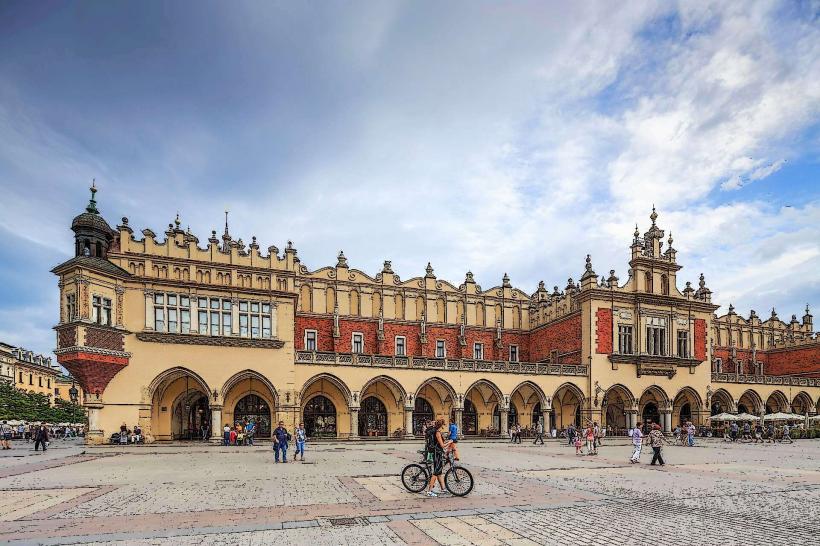Information
Landmark: St. Mary's BasilicaCity: Krakow
Country: Poland
Continent: Europe
St. Mary's Basilica (Polish: Bazylika Mariacka), located in the heart of Kraków's Main Market Square, is one of the most important and iconic landmarks in the city. It is a masterpiece of Gothic architecture and holds significant religious, historical, and cultural value. The basilica is dedicated to the Assumption of the Blessed Virgin Mary and is a prominent symbol of Kraków’s religious heritage.
History and Significance
Early History: The origins of St. Mary's Basilica date back to the 13th century. The first church on the site was built around 1220, but the current structure was erected over several centuries, starting in the late 14th century. The church was built on the site of an earlier Romanesque structure that had become inadequate for the growing city.
Construction and Development: The basilica’s construction took many years, with significant contributions from various architects, artists, and patrons. The church was initially built in Gothic style, but over time, elements of Renaissance and Baroque styles were incorporated, particularly in the altars and decorations inside the church.
Role in the City: St. Mary's Basilica has served as a significant religious center for centuries. It was not only the parish church for the citizens of Kraków but also a site for important events such as royal coronations, civic ceremonies, and significant religious celebrations. The church's central location in the Main Market Square also means it has always been a focal point of civic life.
Symbol of Kraków: The basilica is one of the most recognizable symbols of Kraków. Its twin towers are visible from many parts of the city, and the church itself is a major draw for both locals and tourists. It has been part of the city’s architectural identity for hundreds of years and continues to be a key location for both religious and cultural events.
Architecture
St. Mary's Basilica is an outstanding example of Gothic architecture, characterized by its verticality, pointed arches, and soaring spaces. The basilica’s construction and design reflect the evolving architectural trends of the late Middle Ages.
Exterior Design: The basilica has a brick façade, typical of Gothic churches, and features twin towers that rise above the Main Market Square. The towers are uneven, with the taller one reaching 81 meters, while the smaller tower stands at 69 meters. The towers are one of the most distinctive features of the basilica and have become a defining element of the Kraków skyline.
Facade and Sculptures: The main entrance of the basilica is framed by a beautifully sculpted Gothic portal adorned with biblical scenes and figures of saints. The facade is richly decorated with intricate stone carvings, depicting scenes from the Bible, saints, and angels.
Interior Design: The interior of St. Mary's Basilica is equally impressive, with its soaring vaulted ceilings, tall windows, and numerous frescoes and stained glass windows that fill the church with light. The nave is wide and expansive, creating a sense of openness and verticality.
The Altarpiece: One of the most remarkable features of St. Mary's Basilica is its main altar, which houses the Altar of St. Mary (Polish: Ołtarz Mariacki). This late-Gothic altar was created by the German artist Veit Stoss between 1477 and 1489 and is considered one of the greatest masterpieces of Gothic art in Poland. The altar features a series of carved wooden figures and scenes from the life of the Virgin Mary, and it is especially famous for its central panel, which depicts the Assumption of the Virgin Mary.
Chapel and Side Altars: The basilica also features several side chapels and altars, many of which are adorned with beautiful paintings, stained glass windows, and sculptures. These chapels are dedicated to various saints, and each offers a unique glimpse into the religious art of different periods.
The Trumpet Call – Hejnał Mariacki
One of the most famous features of St. Mary's Basilica is the Hejnał Mariacki, the trumpet call that is played every hour from the higher of the two towers. The tune is a well-known part of Kraków’s heritage and has become a symbol of the city. The melody is played by a trumpet player, or trumpeter, who is positioned at the top of the taller tower.
History of the Hejnał: The tradition of playing the Hejnał dates back to the 14th century and is said to have originated as a signal to the city’s residents, especially to warn them of danger. According to legend, the trumpet call was interrupted in 1241 by the sound of a Tatar invasion. The trumpet player was shot in the throat during his call, and since then, the tune has been played with a cut-off note to commemorate the tragic event.
Modern Tradition: Today, the Hejnał is played four times a day: at midnight, 6 a.m., 12 p.m., and 6 p.m. The trumpet player performs the melody in all four directions from the tower to ensure it can be heard throughout the city. The Hejnał is not only a significant musical tradition but also an integral part of Kraków’s cultural identity.
Art and Artifacts
St. Mary's Basilica houses numerous religious artworks and artifacts, many of which reflect its long history as a center of worship and royal patronage.
Frescoes and Stained Glass: The church is home to beautiful frescoes on the ceilings, as well as stunning stained glass windows, which depict scenes from the life of Christ and various saints. These works of art are especially noteworthy because they have been preserved for centuries, maintaining their vivid colors and intricate details.
Religious Relics: The basilica also contains important religious relics, including the reliquary of St. Stanislaus (the patron saint of Poland). These sacred items are displayed in the chapels and have been part of the basilica’s spiritual and cultural life for centuries.
Monuments and Tombs: St. Mary's Basilica also serves as the final resting place for several prominent individuals in Polish history, including bishops, nobles, and artists. The tombs and funerary monuments within the church reflect the important role it has played in Kraków’s religious and civic life.
Visitor Experience
St. Mary’s Basilica is a major tourist attraction in Kraków and is open to the public for both religious services and guided tours.
Visiting the Basilica: Visitors to the basilica can admire the Gothic architecture, explore the art collections, and learn about the history of the church through informative signs and guides. The Altar of Veit Stoss is one of the highlights of the interior, and many visitors come specifically to see this masterpiece.
Masses and Religious Services: St. Mary’s Basilica remains an active church, and daily masses and religious services are held. Visitors are welcome to attend these services, which offer an opportunity to experience the basilica’s spiritual atmosphere.
Opening Hours and Tickets: The basilica is generally open to visitors during the day, but there may be restrictions during religious services or events. There is typically an entrance fee for those wishing to visit the interior, though the exterior and the Hejnał performance are free to enjoy.
Conclusion
St. Mary's Basilica is a must-visit landmark for anyone traveling to Kraków. Its stunning Gothic architecture, rich history, religious significance, and cultural heritage make it one of Poland’s most important churches and a highlight of the city. Whether you’re interested in history, architecture, art, or music, St. Mary’s Basilica offers an unforgettable experience that connects visitors to centuries of Polish religious tradition.



